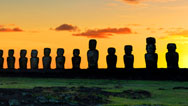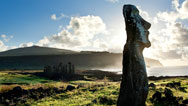Levers: Raising the Moai on Easter Island
- Teacher Resource
- Posted 02.20.04
- NOVA
In this video segment adapted from NOVA, a team of archaeologists and engineers tests one theory of how the ancient peoples of Easter Island (Rapa Nui) might have transported a massive statue, called a moai, from cliff-top quarry to coastal perch and then raised it to an upright position. Levers are simple machines that can help amplify lifting force. As the scientists and local participants discover, even with the mechanical advantage of a lever, the challenge is decidedly difficult and extremely time-consuming.
Permitted use:
![]() Download and Share
Download and Share


- Media Type: Video
- Running Time: 4m 48s
- Size: 14.4 MB
- Level: Grades 3-12
-
Log in to Teachers' Domain to download, share, rate, save, and match to state standards.
Source: NOVA: "Secrets of Lost Empires: Easter Island"
This resource was adapted from NOVA: "Secrets of Lost Empires: Easter Island."
Background
The most common lever systems have four components: a lever arm, or length of relatively stiff material; a fulcrum on which a lever balances or pivots; the load, which is the weight or resistance that needs to be moved; and effort, or the force applied to the lever. In a class one lever (there are three classes of levers in all), the fulcrum is positioned between the load and the point where the effort is applied. One end of the lever arm goes under the object to be moved. When downward force is applied to the other end of the arm, the arm pivots on the fulcrum. This pivoting action raises the end of the arm under the object to lift it.
A lever's mechanical advantage -- that is, the degree to which it amplifies force -- is determined by the ratio of its lever arms. The more you increase the distance over which you exert force, the more you can decrease that force and still get the job done. The closer the fulcrum or pivot point is to the weight, the less force you have to use and the easier it is to lift the weight. If a lever arm is positioned across a fulcrum so that the side from which you'll exert force is 10 times longer than the load side, you can use it to lift a 1,000-pound object by applying a force of only 100 pounds. To do so, however, you'll have to push your lever arm 10 times farther than the load moves.
Compare the weights of Egyptian obelisks and Rapa Nui moai to other objects in this NOVA classroom activity.
Questions for Discussion
- Using a sketch, explain how the force applied by a lever is affected by its distance from the fulcrum.
- In what ways is using a screwdriver to remove the lid of a paint can similar to using a lever to turn the moai on its sled? Can you think of other everyday examples in which levers or lever actions are used to make jobs easier?
- Why should the task get easier once the moai passes the 45-degree angle?
- Why was friction important as the moai was raised?
- Before modern machines, humans built and moved many large things using simple mechanical principles. Do you think that those works (Easter Island, the Great Pyramids, Stonehenge) are more significant than the current large-scale projects that people build (skyscrapers, sporting venues)? Explain why or why not.
Related Resources
-

The Fate of Easter Island
Should what happened on one small island in the South Pacific serve as a cautionary tale for the world as a whole?
-

Pioneers of Easter Island
Most scholars agree the first Easter Islanders were Polynesian, but how to explain the sweet potato and Inca-like walls?
-

Polynesia's Genius Navigators
How did the ancient sailors of the South Pacific find their way to Easter Island and other distant specks of land?
-

Raising an Obelisk: An Engine...
This video segment adapted from NOVA follows two teams as they each test a different engineering design in a...





